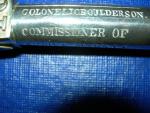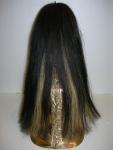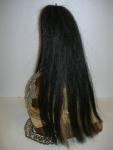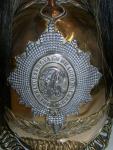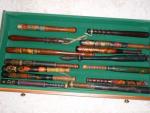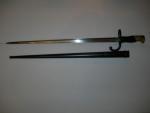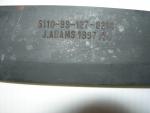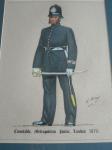-
Posts
13,225 -
Joined
-
Last visited
-
Days Won
22
Content Type
Profiles
Forums
Blogs
Gallery
Events
Store
Everything posted by Mervyn Mitton
-
Kind of you to look - they came from the family and the date sets them as an officer's private purchase? These 'mysteries' are sent to try us - I have a very rare DFM from WW1 - bought from the man's daughter -but, we later found out that the numbers don't tie in and the lettering is different from some examples. He was an ace with the RNAS and shot down 7 German planes - he started as a marine on the first RNAS airship - 'Nulli Secundus' - there are pages on his service on the internet , incl. that he joined again in WW2 and after a year on atlantic patrols was discharged, due to age and spent the rest of the war in the ARP. I will post the info.. I have if you would be interested ? Mervyn
-
After the Mutiny had been concluded - and we had finished tying the mutineers over canon mouths and then firing them (!) - the British took over from the East India Company. One of their first acts in 1860 , was to set-up police forces - not entirely on the new British system , but certainly with an officer administration based on the British ideas from 1829. I mentioned earlier, that three main cities were selected to be regional force H.Q.'s and the officers in charge , were styled Commissioner. Our hero - from the 35th.Regt. M.N.I.( - probably all blown-up, if they rebelled - ) was created the first police commissioner for Madras Province. I have sold this tipstaff some time ago - I often wonder if the person who bought it realises just how historically important it is - despite it's small size.
-
Very rarely do you find police and military associated on truncheons and tipstaffs. This example is not only unusual, but extremely rare from the historical viewpoint. The East India Company was set up in the time of Charles 2nd. to adminster trade - mainly with India - as they grew in wealth and power they took over territories and to adminster them, had their own army, navy and a full civil administration. The army was large and was created, mainly from local forces, but with English officers, in different areas of India. After the Mutiny, Britain took over control of India and created new armies and a Police force - this last was centred in three main cities - Bombay, Madras and Delhi. This silver plated tipstaff - on brass - has Queen Victoria's crown and cypher at the top - it is approx. 7 inches overall. The owner - as inscibed around the barrel , was : J.C.BOULDERSON. Major 35th. Regt. M.N.I. Nov. 1856. 35th were one of the regiments of Madras Native Infantry - I think they numbered 39 or, 40 in total.
-
I recently saw under one of the topics, some interest in S.A. shoulder flashes. These are for Pretoria and Johannesburg traffic departments and are pre 1994 - the star is interesting , copying the US Sheriffs. In addition to traffic, they also had a police function, with a general power of arrest. mervyn
-
Stuart Thankyou for that info. - I have a book on their service in Sth. Africa in the 1840's and thought it looked similar. I also have a lovely example of the King's Dragoon Guards - Edward V11 - will post it another time. I would also like to purchase a copy of your new book - sounds very informative - congratulations. We occasionally have the topees from Boer War and, also, the WW2 S.A. sun helmet. The Zulu War British ones are now very hard to find - although the Boers bought a lot of surplus ones and used them for the ZARPS (police) and the President's Guard. Mervyn
-
Interesting and very rare poster to advise the residents of Shadwell in 1818 - who their constable was on given dates and , who to call for fires. Shadwell is the area beyond the Tower of London - going East. It was a poor area and notorious for crime - the infamous Ratcliffe Highway ran through the area to give access to the West Indies Docks and ships. Should some one in those days commit suicide - or, be executed, they could not be buried in Consecrated ground and were buried in the centre of crossroads. I was stationed at Bethnal Green - next to this area - and quite regularly skeletons were dug up, from old cross roads. The new Canary Wharf and the City airport are now at the far eastern end - I bet the people 200 years ago didn't expect that to happen !!
-
This wonderful helmet is for an officer of the 7th. Dragoon Guards - The Princess Royal's . They were first established in 1688 on the accession of King William 3rd. They served in the Cape from 1843 to 1848 and I think this helmet is about that date. It has a beautiful silver helmet plate with Queen Victoria's cypher and unlike their later badges the plate is shaped like a breast star. Dragoons are heavy cavalry and wear cuirasses - officers used to wear gold plated helmets in order to be seen clearly through the dust in battle. How they were formed is interesting - The Princess Royal ( the first to have this title - now usually given to the eldest daughter of the Monarch) Mary, was the daughter of Charles 1st. and became the Mother of William - Prince of Orange in the Netherlands. When Charles 2nd. died in 1685, his brother becames James 2nd. - however, he was Catholic and was driven out in 1688 (he later became the 'old pretender' and his son - Bonnie Prince Charlie, became the 'young pretender'). Just after Charles died The Princess Royal fled towards York to escape prison - the Earl of Devonshire came to her rescue with his guard. When William became King one of his first acts was to give Devonshire a Dukedom and allowed him to form the 10th.Horse - later the 7th Dragoons - The Princess Royals'. Since 2006 they are the Royal Dragoon Guards , with the 4th. and 5th Dragoons. The man who brought it in , paid ?10 - in a pub - in the 1950's !!!
-

FRENCH 19 th. CENTURY BAYONET
Mervyn Mitton replied to Mervyn Mitton's topic in Swords & Edged Weapons
Thankyou. I was nearly right !! -
Ross Mather asked if I had any Welsh truncheons and when I was looking for some I came across this picture - some of the truncheons are interesting and I will list them. At one time there would have been over 40 in any drawer. From top - left: 1. brass weighted short truncheon William 1V (1830-37) 3. Bradford Borough Police 1868. This was when Sein Fein (IRA) started and they planned to seize weapons at Chester Barracks and start an armed up-rising in Ireland. Thousands of special constables were sworn in all over the UK and the date 1868 is common on S.C.'s truncheons. I will post the side door panel from a 'Black Maria' - old name for a horse drawn prisoners waggon. The two leaders had been arrested and were on their way to Court in Manchester - their accomplices ambushed the Black Maria and killed the Sgt. in charge. The two leaders escaped and went to New York - they were never captured, however, the men who attacked the van were hanged at Manchester Belle Vue Prison. (Didn't bring the innocent Sgt. back though !) 5. Glamorganshire Police truncheon - Victorian - prob. about 1880's. From top - right : 1. Standard teak issue truncheon - in use until the ASP took over. 2. Swansea Borough Police. Again, Victorian (1837-1901). 4. Well painted George 1V truncheon - with coat-of-arms. However, I can't remember for which town. 5. William 1V 6. A nice short Manchester truncheon - pre-dates formation of City Police, so probably George 1V 7. Very interesting old decorated truncheon for Bristol. I had this from the family, and he had taken part in the Bristol Riots (not sure of the date - prob. mid 1850's, or, later. He was badly hurt and his truncheon splintered when he hit someone - so I hope they were as well! I was told he eventually returned to work, but tied up his old truncheon and always carried it on duty I hope these are of some interest? Mervyn
-

FRENCH 19 th. CENTURY BAYONET
Mervyn Mitton replied to Mervyn Mitton's topic in Swords & Edged Weapons
-
I believe this to be the French Lebel bayonet - date on blade shows approved pattern in 1886. Was this for the Minie rifle , or , musket?
-
I believe this to be the French Lebel bayonet - date on blade shows approved pattern in 1886. Was this for the Minie rifle , or , musket?
-
re. Tom's comment on a leather stick being carried - I cannot recall seeing one, unless it was like a riding crop for the horse ? Can you recall any other details - it just 'might' have represented a staff of office ? Jamie - when are you going to post some more of your sepecial helmets - with Ross now joined we should see some exceptional items. Mervyn
-
Brian - this is a 1st. WW duty armband and was worn around the upper left arm. (exceptional cond. !) However, the horizontally striped band (without the name plaque) would have been very similar to the early Victorian ones. The duty arm bands were worn on the left sleeve of the tunic or, greatcoat - and the sleeves on both had sewn loops to stop the band from falling off.
-

HELP WITH BRIT. ARMY (?) KNIFE
Mervyn Mitton replied to Mervyn Mitton's topic in Swords & Edged Weapons
"Ask - and ye shall receive !" Leigh, Thankyou so much for that info. - greatly appreciated - and the speed of the reply !! I paid Rands 100 = approx.?7 - does that seem reasonable? One other question - were they issued individually - as per name and no.on blade and , to everyone overseas? Again, thankyou. Mervyn -

HELP WITH BRIT. ARMY (?) KNIFE
Mervyn Mitton replied to Mervyn Mitton's topic in Swords & Edged Weapons
-
I woder if any member can help with more info. on this knife - which I have just purchased. The photo is a little dark, so, details as follows - about 10 inches overall, heavy and with Br. services broad arrow and - presumably - the man's name and number (next photo.) I did not get a sheath or, a frog . Is this a standard issue - like the old WW" folding knives - or, is it for a specialist unit. Thankyou for any assistance. Mervyn
-
Sorry, I forgot to answer your question on duty armbands. They were present from when the Met. first marched out in 1829 and their purpose was very simple. Police Orders of the day, laid down that the 'new' police were on duty 24 hours a day and would wear uniform at all times. To distinguish between when they were 'on' or, 'off' duty they carried the arm band and put it on when 'on' duty. The stripes were horizontal. I am not sure of the exact date they changed to vertical stripes, but it was sometime in the 1880's (I stand to be corrected on this , if anyone has diff. info.). I was first issued with a felt type armband and in ,I think, 1970, we changed to nylon ones. They were taken away in 1972 and we all felt annoyed, as it was part of the uniform. Only City of London retained theirs - which are red and white vertical stripes. Will post my old ones. Did Specials ever wear them - not sure ?
-
I'm a little out of date on Met. current full dress - the last Trooping of the Colour I paraded for was in 1974 - it was the only thing I ever volunteered for - and that was only because my Div. 'H' - stood in front of the Guards Memorial - so, we had the best view !!! The Deputy - or, sometimes , Asst. Commissioner, who was in charge of the parade, would ride on horseback, along the Mall 15 minutes before the Troops - he would be accompanied by his his sgt. orderly, from Mounted Branch. The Sgt. was in No.1 dress uniform and the 'boss' in cocked hat, full dress uniform , with Austrian frogging - and, if raining, a beautiful horse cloak with velvet collar - this was stretched out to sit across the back of the horse. From my re-collection , I think he wore a dress sword. One must remember that the Commissioner is the most senior police officer in the UK and has an equivalent army rank of full general . He wears as rank - crown,star and crossed tipstaffs in a wreath. The Dep.Comm. wears crown, two stars (side by side) and tipstaffs. His equivalent is a Lt. Gen.. The asst. comms wear a star, over the tipstaffs - equiv. of major generals. I would think with today's changing of values, that he probably rides a bike now and in shirt sleeve order !!! Inspectors' and supts. carried swords until about the 1870's - they are now very rare - I will post one soon. Mervyn
-
Another Andy May (in South Africa) original. This shows a Met . P.C. in 1870 - carrying this pattern of sword. Each Station had it's own armoury of swords and pistols. These could be issued when required, or, when asked for by the constable - the station sgt. or, duty officer was responsible. It is not generally known that as late as the 1930's a constable could request a firearm if patrolling a very dangerous beat.



